What You Should Know
What You Will Learn
- What a power chord is
- Various power chord voicings
- How to change between different power chords
Introduction to Power Chords
What is a Power Chord?
Power chords are one of the most important aspects of rhythm guitar in rock music. They have been used in many styles, including rock, punk, and heavy metal.
Power chords consist of only two notes: a root and a perfect fifth above the root. These chords are represented by a chord symbol that includes the root pitch and the number '5'. For example, C5 represents a C power chord, which would be C G.
Power Chord Voicings
Power chords are generally played in two different ways:
- 1. With just the root and fifth on two adjacent strings.
- 2. With the root doubled an octave higher. This will be played on three adjacent strings.
Chord voicings that use two and three strings are discussed in detail below.
E5 Power Chord
There are several power chords that can be played with the root on an open string. The first of these is an E5 chord.
Two-string E5 Chord
Chord Diagram

Tablature
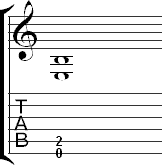
Three-string E5 Chord
Chord Diagram

Comments
This is another form of the E5 chord where the root (E) is doubled an octave higher. This creates a thicker-sounding chord. Barre the second fret of the fourth and fifth strings with your index finger.
Tablature
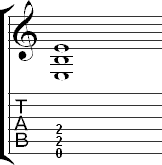
A5 Power Chord
A5 is another power chord that can be played with an open string as the root.
Two-string A5 Chord
Chord Diagram

Comments
A5 is the same shape as the E5 chord, but moved to the fifth string. Try to avoid hitting the sixth string as you play this chord. It will be easier to do this if you return to a position directly above the fifth string after each strum.
Tablature
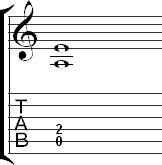
Three-string A5 Chord
Chord Diagram

Comments
The three-string version of A5 requires a barre like the three-string E5.
Tablature
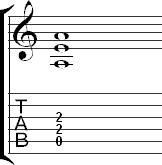
Movable Power Chords
There are two power chord voicings based on the open power chords you learned earlier that can be moved around the neck.
Two-string Movable Power Chord
Chord Diagram

Comments
This is a two-string movable power chord that can be moved up and down the whole neck. It can be played on every pair of strings except for the second and third. The root of the chord is the lowest note in the chord, so you can play the chord on any root by knowing the notes on the fretboard. For example, if you wanted to play a G5 chord, you could play this at the third fret of the sixth string by knowing that the pitch at the third fret is a G.
Tablature
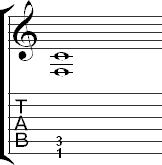
There is also a movable three-string power chord voicing. This voicing can be played with several different fingerings. No one fingering is more correct than another and you may need to use different fingerings in certain situations. You should choose the one that works best for you. Each of these fingerings is shown below:
1. Barre the fourth and fifth strings with the pinky.
Fingering 1 - Three-string Movable Power Chord
Chord Diagram

Comments
This fingering may work better for people with small hands. It requires the smallest stretch of the three fingerings.
Tablature
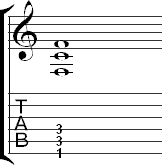
2. Play the fifth string with the ring finger and the 4th string with the pinky.
Fingering 2 - Three-string Movable Power Chord
Chord Diagram

Comments
Fingering 2 doesn't require a barre, so it may be easier for beginners. However, you should eventually learn one of the other fingerings.
Tablature

3. Barre the fourth and fifth strings with the ring finger.
Fingering 3 - Three-string Movable Power Chord
Chord Diagram

Comments
This fingering requires a wider stretch than the other two fingerings. Don't use this fingering just to avoid using your pinky. Your pinky will only develop if you use it. That said, this fingering does work well in certain situations where it is necessary to have your pinky free so it can play other notes.
Tablature

Tips for Playing Power Chords
Strumming Power Chords
Power chords are often played with only downstrokes. This tends to give a thicker sound due to the bass strings being struck first. However, you should experiment with alternating downstrokes with upstrokes. You may like the sound or may need to play music that is too fast to be played with only downstrokes.
Locating Power Chords on the Neck
Power chords are easy to find if you know the notes on the guitar. They are most commonly played on the fifth and sixth strings, so knowing the notes on these two strings will allow you to play chords on any root. To locate a power chord, simply find the root of the power chord on a string and play one of the power chord voicings at that fret. For example, to play a G5 chord, you need to find a G. One possibility is the G on the third fret of the sixth string. Below is an example of a G5 chord:
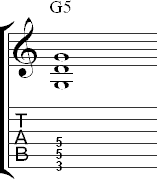
Basic Exercises
These introductory exercises are designed to get you used to fretting and strumming power chords. Play each of the exercises below with all downstrokes and then with upstrokes and downstrokes. Make sure that each note in the chord is ringing clearly. The exercises are shown with E5, but should be practiced with all of the two- and three-string voicings given above.
Exercise 1
Exercise 1 is an E5 chord played in half notes. Try to make your strums efficient. Only play the strings in the chord and quickly get in position for the next strum. If you are using all downstrokes, you need to return to a position directly above the strings as soon as you finish one downstroke in order to prepare for the next downstroke.
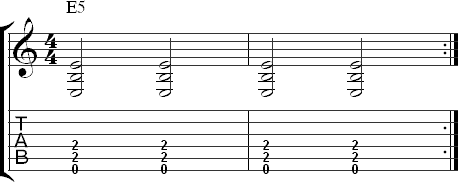
Exercise 2
Exercise 2 is similar to the first exercise, but in quarter notes.
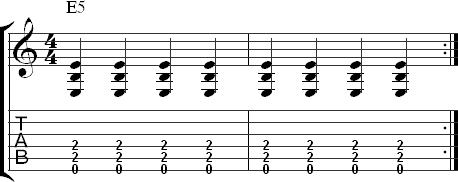
Switching Between Different Power Chords
Changing between different power chords is relatively easy compared to other chord changes. This is because the fingerings for each power chord voicing are closely related.
Exercise 3
Exercise 3 is an exercise for switching between an open E5 and A5 chord. This change should be easy because you only need to move your index finger.
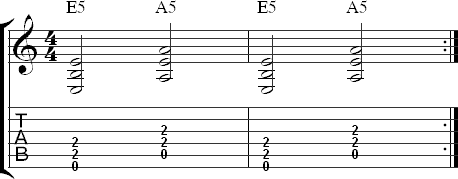
Exercise 4
Exercise 4 requires you to switch between E5 and A5 in quarter notes. Work on this only after you are able to play Exercise 3 smoothly.
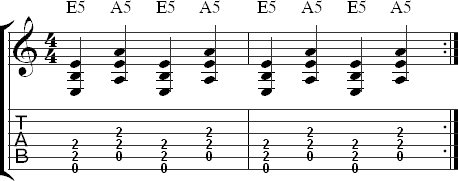
Exercise 5
The exercise below is a chord progression in G using movable power chord voicings. The exercise is shown with three-note voicings, but you should also try it with two-note voicings. Lift your fingers off the strings when switching between chords to avoid string noise, but make sure to keep your fingers in the same shape while switching to prepare for the next chord.

Exercise 6
Exercise 6 is a chord progression in E major that includes a mixture of open and movable power chord voicings. Because of this, the exercise will be more challenging than the other exercises. Practice slowly and form the shape of the chord in the air as you make the switch to each voicing.
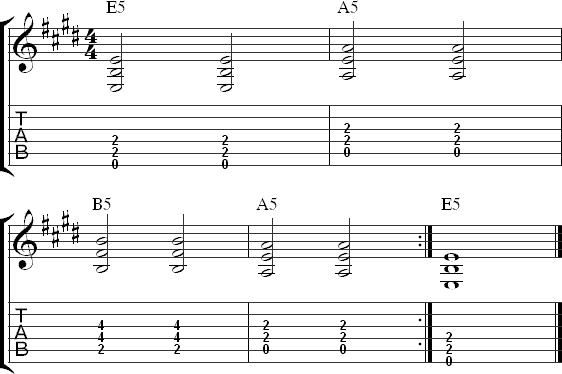

Comments
Fret the second fret of the A string with your index finger. Try to strum only the fifth and sixth strings when playing this chord.